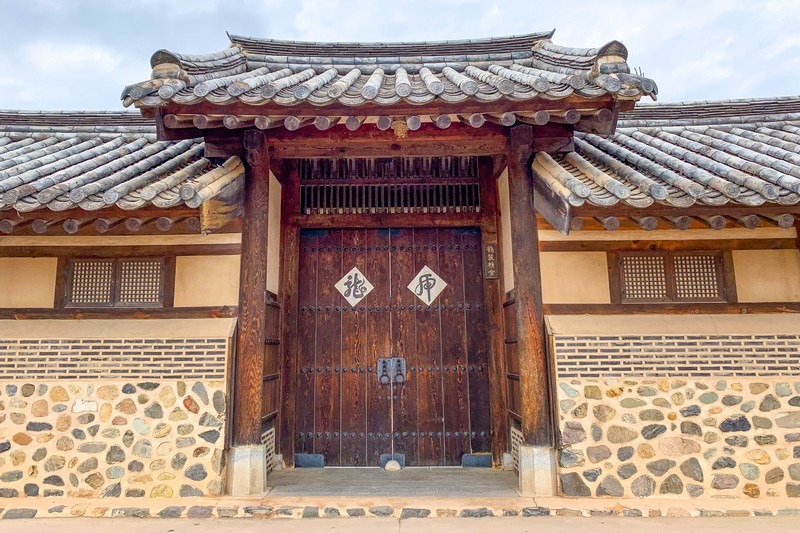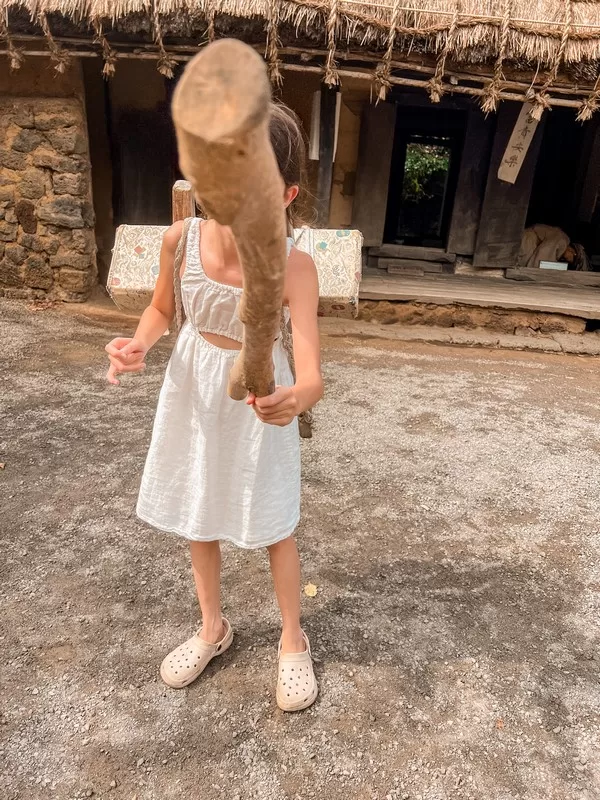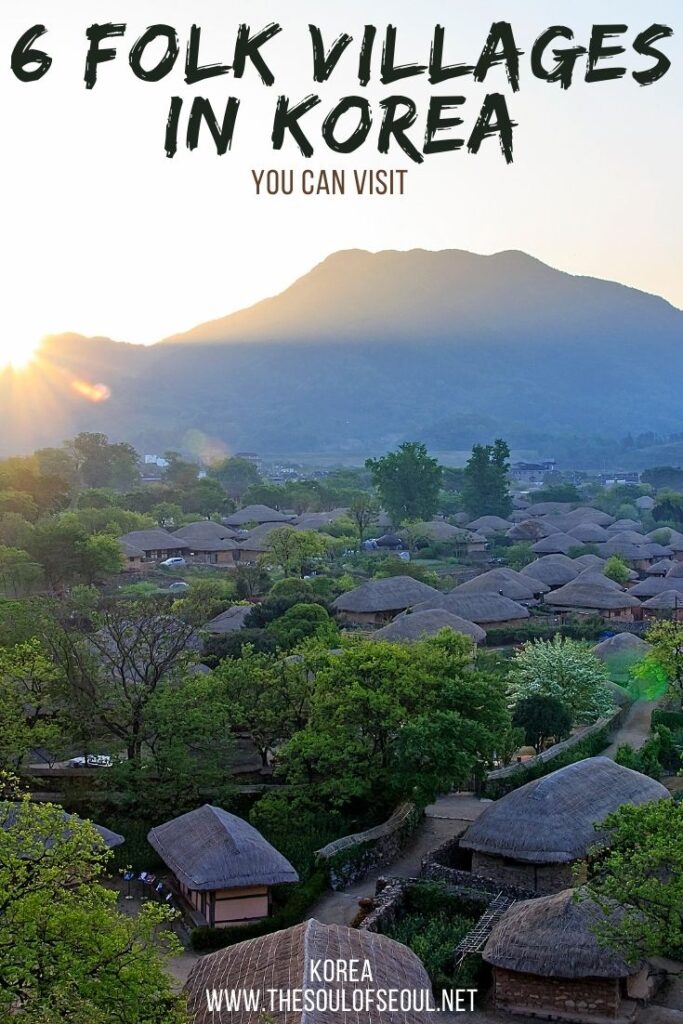6 Folk Villages In Korea You Can Visit
Last Updated on April 10, 2025
There are some really popular folk villages in Korea, but there are also some that are retaining the traditions but have lesser crowds. Whether you’re looking for a touristy experiential filled folk village or a living museum folk village, there are different ones to find all around Korea.
Folk villages tend to be quieter and less populated areas to tour in my experience and they’re also beautiful year-round. Whether you’re a tourist in Korea or a resident, you need to visit one, or maybe six, folk villages while you’re here. They’re a completely different vibe and really show more of Korean history than you might realize.

Take A Trip To Some Hidden Folk Villages!
- What To Prepare To Travel Around Korea
- Naganeubseong Folk Village (순천낙안읍성)
- Andong Hahoe Folk Village (안동하회마을)
- Yongin Korean Folk Village (용인한옥민속촌)
- Jeju Folk Village (제주민속촌)
- Seongju Hangae Folk Village (성주한개마을)
- Goseong Wanggok Village (고성왕곡마을)
(This post contains affiliate links, which means I receive a certain percentage of a sale if you purchase after clicking at no cost to you. Thank you for your support.)
What To Prepare To Travel Around Korea
International Driver’s License: Roadtrips can make for great adventures. I don’t recommend driving in Seoul, but when it comes to getting outside of the city, getting a car is a great option. If you will rent a car, then remember to bring your International Driver’s License. I highly recommend renting a car if you’ll be headed to Jeju Island or anywhere aside from Seoul and Busan because it’s much easier to get around that way in those cases.
Korea Rail Pass: If you want to get out of Seoul and plan to use the train more than twice, then the Korea Rail Pass is the economical/budget choice you want to have on hand. Grab the card here and just head to the station with your confirmation and it’s as easy as that.

Naganeubseong Folk Village (순천낙안읍성)
Considered the best-preserved Korean fortress town in the country, this is absolutely something you need to see in Jeollanam-do. Not only is it the best preserved, but it’s still active! There are 100 households with a bit over 200 residents that live in the traditional thatched roof homes in the village. It’s pretty amazing really.
The site of the village has been inhabited since the beginning of the first millennia and became a fortress village in the early 10th century during the Goryeo Dynasty. The Jeollanam-do province was and is an extremely fertile area and so it was often the target of invasion and prone to attacks prompting the need for a fortress town. The village began to really flourish in the late 1300s during the Joseon Dynasty when there were more than 330 fortress towns across the Korean peninsula.


Today, there are 231 houses here that are still in their original condition with thatched roofs, mortar-free stone work, no plumbing, and living spaces that are much smaller than the average home today. And what is especially unique about the village is that not only are the homes in their original state but there are actual residents that occupy the homes and still live a very traditional lifestyle.
The town became an UNESCO World Heritage site in 2011 and while still very residential, offers a lot to tourists to Suncheon. You can actually walk along the top of the fortress wall, not beside it like so many other fortress walls, which gives you great views of the roofs, there are experiences and food to eat there too. Learn more about Naganeubseong Fortress here.
Plan A Trip
- Address: 30 Chungmin-gil, Nagan-myeon, Suncheon, Jeollanam-do (전남 순천시 낙안면 충민길 30)
- Days: Every day
- Hours: Vary by season; November to January: 9 am to 5:30 pm; February to April (and October): 9 am to 6 pm; May to September: 8:30 am to 6:30 pm
- Admission: Adults are 4,000 won and children are 2,500 won each.

Andong Hahoe Folk Village (안동하회마을)
Listed as an UNESCO World Heritage Site in 2010, the Andong Hahoe Folk Village is quite huge and you could easily spend the better part of a day walking along the small alleys and roads in this beautiful traditional village. This traditional village dates back to the Goryeo period in Korea from 918 to 1392. Surrounded by the Nakdong River, the houses in this village are unique in that they have thatched roofs. Walk along the village and notice the signs which let you know which houses you can enter.
Even if you haven’t been to Andong, you’ve probably spotted the traditional masks from the region all over the place. Visit in the autumn when the Andong Mask Festival is taking place and you’ll be dazzled by the fun, history, and culture. This is one of the more popular folk villages in the country and for good reason. It’s worth a day in the area. Check out this guide to Andong to plan a trip there.
Plan A Trip
- Address: 2-1 Hahoejongga-gil, Andong-si, Gyeongsangbuk-do (경상북도 안동시 풍천면 하회종가길 2-1)
- Days: Every day
- Hours: April – November: 9:00am ~ 7:00pm; November – March: 9:00am ~ 6:00pm
- Admission: W5,000

Yongin Korean Folk Village (용인한옥민속촌)
While some of the villages on this list are living villages, this is a living museum. Popular with both foreigners and locals, the Korean Folk Village has real houses from across the country that were relocated and restored here to create a replica village from the late Joseon Dynasty. This village is huge with over 260 traditional houses and you can see traditional houses from different social classes.
This open-air museum has a lot of experiences and crafts for visitors which makes this ideal if you want to do a lot while you visit. From horseback riding to natural dying and other traditional crafts, you can also see a traditional wedding ceremony here. This is a full entertainment space with food and fun and performances too on top of the cultural and historical information.
Plan A Trip
- Address: 90 Minsokchon-ro, Giheung-gu, Yongin-si, Gyeonggi-do (경기도 용인시 기흥구 민속촌로 90 (보라동))
- Days: Every day
- Hours: February – April, October: weekdays: 9:30am ~ 6:00pm; weekends: 9:30am ~ 6:30pm; May – September: weekdays: 9:30am ~ 6:30pm; weekends: 9:30am ~ 7:00pm; November – January: weekdays: 9:30am ~ 5:30pm; weekends: 9:30am ~ 6:00pm
- Admission: Adults: W18,000; Teenagers: W15,000; Children: W13,000
- Buy discounted ticket: You can get discounted admission on Klook.

Jeju Folk Village (제주민속촌)
Another really interesting folk village is this one on Jeju Island. There are more than 100 houses that were actual residences and they’ve tried to portray what time was like in the 1890s on Jeju Island. An interesting thing about the Jeju Folk Village is that it brings together the various living styles of the island in one place. So it feels like a few villages instead of just one.
There’s a mountain village area, hill country village, fishing village, and shamanism village. It’s really interesting to see the differences in homes that may seem subtle to some but if you know what to look for, you’ll find them.
One of the things I learned about was having bamboo over the door frame or just in the door frame. Apparently, it was placed there so that people had to lower their heads thereby bowing to the upper-class owners inside. Just something interesting you’d learn when you visit.



There are a ton of items on display to learn about traditional life specific to Jeju island at the end of the 1800s. Life-like dolls help to explain what the buildings were used for, how people looked, and how they may have looked back in the day. There are also performances but check the schedule when you arrive to know where they are and what time. There are even monthly events. Of course, there are also folk games, and traditional experiences to try.
You can easily spend half a day here learning, walking, and experiencing this folk village that was planned with a lot of painstaking historical research. Really beautiful spot to find on Jeju.
Plan A Trip
- Address: 631-34 Minsokhaean-ro, Pyoseon-myeon, Seogwipo-si, Jeju-do (제주특별자치도 서귀포시 표선면 민속해안로 631-34)
- Days: Every day
- Hours: Vary by season; October to February: 8:30 am to 5 pm; March: 8:30 am to 5:30 pm; April to July 15th: 8:30 am to 6 pm; July 16th to August 15th: 8:30 am to 6:30 pm; August 16th to September: 8:30 am to 6 pm
- Admission: Adults are 11,000 won, teens are 8,000 won, and children are 7,000 won

Seongju Hangae Folk Village (성주한개마을)
This traditional folk village is a living village meaning that there are residents in the cottages that are 600 years old. Today, there are 60 cottages and houses to walk along. As you walk through the village, you can read signposts outside of various homes that talk about the distinguished people that lived there. Among them is Lee Seung Hui, an independence activist who was committed to the “save the nation movement” at the end of the Great Korean Empire and was forced into exile to Vladivostok, Russia in 1908.
There are numerous interesting tales of the people that have come from this traditional Hanok Village and beautiful Hanok lined lanes to walk along. Head to the back of this village and you can also find a bamboo forest. Find out more about the Seongju Hanok Village here.
Plan A Trip
- Address: Gyeongsangbuk-do Seongju-gun Wulhang-myeon Hangae 2-gil 8-5 (경상북도 성주군 월항면 한개2길 8-5)
- Days: Every day
- Hours: 9:00am ~ 6:00pm

Goseong Wanggok Village (고성왕곡마을)
Goseong is the furthest north you’d go as it is in the northeast corner of Korea. It’s a region that is not super touristy so there’s much to see, but it can be a bit of a trek to get there, so be prepared for that.
This village is much like the first one that was mentioned where the residences with thatched roofs and tiled roofs built in the 19th century are still being lived in today. It’s not as large as the other two villages mentioned. It only has 21 traditional northern-style Hanoks. The village is surrounded by five peaks that protected it during the Korean War, so it was never destroyed surprisingly as it is so far north.
Wanggok Village also hosts a folk festival from July to October so that’s usually the best time to visit this particular one if you want to see more traditional ceremonies and customs in action. This village is best experienced by staying there as well. There are pensions that you can stay for the night which I would recommend if you have the time.
Plan A Trip
- Address: 36-13 Wanggongmaeul-gil, Jugwang-myeon, Goseong-gun, Gangwon-do (강원 고성군 죽왕면 왕곡마을길 36-13)
- Days: Every day
- Hours: 9:00am ~ 6:00pm
Did you know there were this many folk villages in Korea that you could visit? How many have you been to so far?
Did you like this post? Pin IT!



